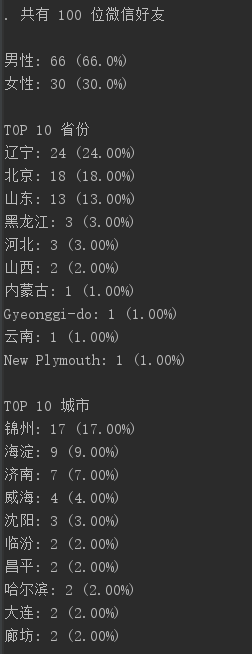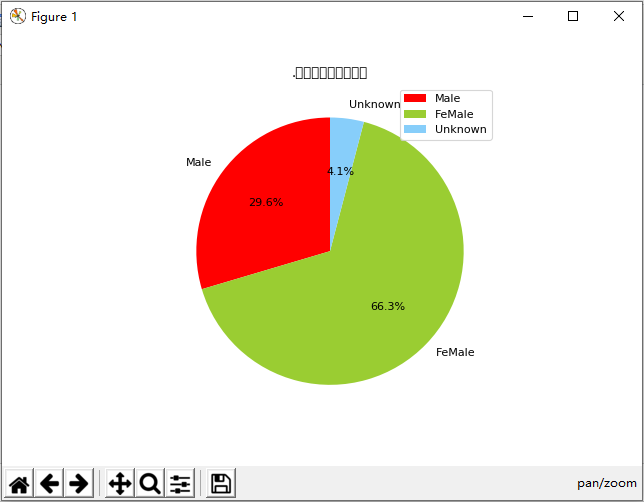最近用闲余时间看了点python,在网上冲浪时发现有不少获取微信好友信息的博客,对此比较感兴趣,于是自己敲了敲顺便记录下来。
一、使用 wxpy 模块库获取好友男比例信息和城市分布。
# -*- coding: utf-8 -*- """ 微信好友性别及位置信息 """ #导入模块 from wxpy import Bot '''Q 微信机器人登录有3种模式, (1)极简模式:robot = Bot() (2)终端模式:robot = Bot(console_qr=True) (3)缓存模式(可保持登录状态):robot = Bot(cache_path=True) ''' #初始化机器人,选择缓存模式(扫码)登录 robot = Bot(cache_path=True) #获取好友信息 robot.chats() #robot.mps()#获取微信公众号信息 #获取好友的统计信息 Friends = robot.friends() print(Friends.stats_text())
得到的好友信息结果

二、使用 itchat 获取好友详细信息并输出到记事本。
import itchat itchat.login() friends = itchat.get_friends(update=True)[0:] def get_var(var): variable = [] for i in friends: value = i[var] variable.append(value) return variable NickName = get_var("NickName") Sex = get_var("Sex") Province = get_var("Province") City = get_var("City") Signature = get_var("Signature") from pandas import DataFrame data = {'NickName' : NickName,'Sex' : Sex,'Province' : Province,'City' : City,'Signature' : Signature} frame = DataFrame(data) frame.to_csv('myFriendanAlyze.txt',index=True)
这个就不展示了,大家想试的话扫描二维码登陆就可以看到自己好友的信息啦。
三、仅输出好友占比。
import itchat itchat.login() friends = itchat.get_friends(update=True)[0:] male = female = other = 0 for i in friends[1:]: sex = i["Sex"] if sex == 1: male += 1 elif sex == 2: female += 1 else: other += 1 total = len(friends[1:]) print("男性好友:" + str(male) + ",女性好友:" + str(female) + ",不明好友:"+str(other))
四、图表展示好友性别分布。
# -*- coding: utf-8 -*- """ Created at 2019-3-25 22:50:49 """ import itchat import matplotlib.pyplot as plt from collections import Counter itchat.auto_login(hotReload=True) friends = itchat.get_friends(update=True) sexs = list(map(lambda x: x['Sex'], friends[1:])) counts = list(map(lambda x: x[1], Counter(sexs).items())) labels = ['Male','FeMale', 'Unknown'] colors = ['red', 'yellowgreen', 'lightskyblue'] plt.figure(figsize=(8, 5), dpi=80) plt.axes(aspect=1) plt.pie(counts, # 性别统计结果 labels=labels, # 性别展示标签 colors=colors, # 饼图区域配色 labeldistance=1.1, # 标签距离圆点距离 autopct='%3.1f%%', # 饼图区域文本格式 shadow=False, # 饼图是否显示阴影 startangle=90, # 饼图起始角度 pctdistance=0.6 # 饼图区域文本距离圆点距离 ) plt.legend(loc='upper right',) plt.title('%s的微信好友性别组成' % friends[0]['NickName']) plt.show()
